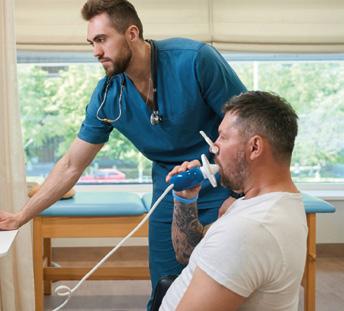
2 minute read
Hat-trick for hospice charity as it scores football club support
Local hospice charity ellenor has kicked off a transformative hat-trick of support, securing a three-year partnership with Dartford FC.
Dartford Football Club will help to raise awareness and support the services the Gravesend hospice provides to patients with a life-limiting illness and their families. The club has named ellenor as its Community Stand Sponsor, and if you’re at their Princes Park stadium, look out for the pitch-side advertising. Donations can be made in collection pots or online via a QR code displayed around the club’s Princes Park Stadium.
As well as inpatient and at-home care, ellenor offers a range of wellbeing and therapeutic services such as hobby groups, play and music therapy, and counselling. Through the partnership, services and ways to support will be shared, including the public café, wellbeing centre, shops and online shopping.
Head of Income Generation with ellenor, Sue Piper, said: “This is a real game-changer for ellenor, helping us to encourage more people in Dartford to support and use our services. It’s a common misconception that a hospice is only for use by people facing their final days – but we’re so much more than that and we invite people to come in and see.
“Our facilities and events are open to all –not just those receiving our care.”
A spokesman for Dartford Football Club said: “We are delighted to partner with ellenor, who carry out amazing work in the community and beyond.
“Not only do we welcome the charity as our new Community Stand Sponsor, but we will be supporting their initiatives to help raise awareness and support the services it provides.
“We look forward to growing our relationship with them.” www.ellenor.org



Health in Construction: Why it deserves more attention
The Hidden Risk on Site
In construction, safety is often front of mind - but health risks are just as serious, and in many cases, even more deadly.
According to the Health and Safety Executive (HSE), an estimated 4,000 former construction workers die each year from occupational diseases linked to past exposures – such as asbestos, silica dust, and other harmful substances. In comparison, around 40 construction workers die annually as a result of onsite accidents.
These illnesses are often the result of long-term exposure to hazards that aren’t immediately visible, including:
• Construction dust (e.g. silica, wood dust)
• Noise and vibration
• Manual handling and repetitive strain
• Solvents, fumes, and hazardous substances
• Work-related stress and fatigue
The Role of Occupational Health
Health risks don’t always show symptoms straight away — which makes early detection and prevention essential. That’s where occupational health comes in.
Key measures include:
• Health surveillance to monitor workers exposed to known risks (like dust or vibration)
• Safety Critical Medicals to assess fitness for roles where sudden health events could endanger others (e.g. plant operators, working at height)
• Fit to Work assessments to ensure workers are physically and mentally able to carry out their job safely
In some cases – such as exposure to hazardous substances or vibration – health surveillance is not just good practice; it is a legal requirement.
Why It Matters www.allhealthmatters.co.uk
Looking after employee health isn’t just about ticking a legal box. It helps prevent long-term harm, reduces sickness absence, and improves staff retention.
It also enhances your company’s reputation — showing clients, employees, and stakeholders that you invest in doing the right thing.
If you’re working in Kent’s construction sector, speak to All Health Matters for sensible advice about keeping workplace health on track.









